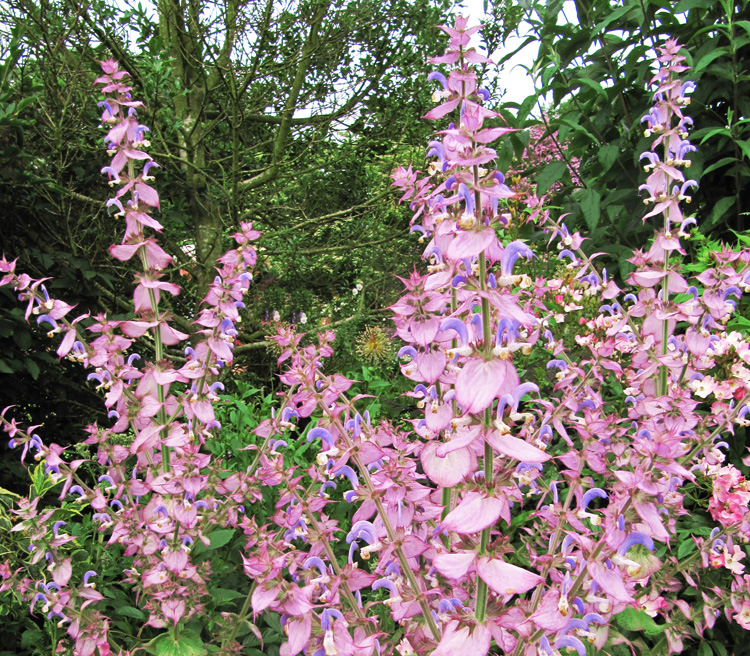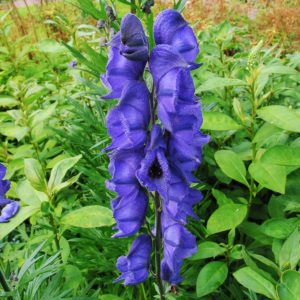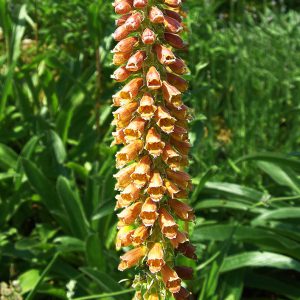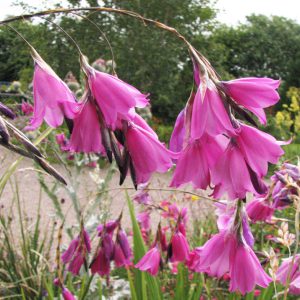Salvia sclarea var. turkestanica ‘Vatican Pink’
VATICAN PINK CLARY SAGE
Billowing big clouds of flowers
Large branching clouds with shades of pink-cream-white, billow up from mid spring right through summer, on spectacular Salvia sclarea var. turkestanica ‘Vatican Pink’.
Because the blooms are actually made up of bracts, they are wonderfully long lasting and weather hardy, even in the hottest times.
So Pink Clary Sage is spectacularly pretty but iron tough.
Leaves are huge, hairy, wrinkly, velvety, and utterly gorgeous
Eye-catching, crinkled grey-green leaves make decorative rosettes of foliage that hug the ground.
Salvia sclarea var. turkestanica ‘Vatican Pink’ is certainly not just a pretty flower show.
Because the velvety, wrinkly foliage would be enough reason for growing it.
But then when it billows up in that cloud of flowers – even the leaves are overshadowed.
Ancient herbal Clary Sage
Clary Sage is an ancient herbal plant.
And it was commonly called “Clear Eye” in centuries past.
So it is easy to see where the name “Clary” has come from.
And the ancient common name also gives the game away for traditional medical uses.
Because it was often used for treating eye infections and irritations of course.
But Clary had a very versatile career as an ancient medicinal plant.
It was also proposed to heal anything from ulcers to scorpion stings; from kidney stones to insomnia.
Dioscorides and Pliny the Elder were both famed healers and botanists in the 1st century AD, and both highly prized Clary Sage. in their medicinal writings.
Even Theophrastus extolled its virtues hundreds of years later in the 4th Century.
And by the dark ages in medieval Europe, ladies were encouraged to drink it in beer or wine to assist with “female problems”.
Modern Clary usage
Clary is still sometimes promoted today in herbal practise, where it is used to combat mental health issues. However pregnant women are strongly advised against its use.
Today, it is more commonly grown in commercial crops, to harvest the aromatic oils for use in fragrant soaps, cosmetics and hair tonics, and even for flavouring food and liquors.
Cut armloads of flowers
Clary Sage also provides excellent cut flowers for large vases.
And you can cut armloads of beautiful branching stems of blooms to bring indoors.
Abundance of fragrance
The whole plant is strongly and pleasantly aromatic in the garden.
Though just like wine connoisseurs, some gardeners say they detect notes of lavender, while others savour hints of bananas and pineapple on the nose.
As tough as nails – thrives on neglect
Clary Sage is native to the Mediterranean area, especially through Syria, Italy, Southern France and northern Africa.
However all are areas that have hot, dry summers, and cold frosty winters.
So this is blissful news for so many Australian gardeners who have similar conditions.
Slavia sclarea is very hardy in heat, dry, frost, and poor soils.
And it is drought tolerant and very water-wise.
Leave it to do its own thing
Clary Sage is a self-seeding biennial. It will reliably seed itself into the garden each year, to provide plenty of new plants each year, as long as you leave a head or two to go to seed each autumn. It is not hard to weed out if it volunteers in the wrong place.
SEED SOWING ADVICE: QUICK & EASY
Sow at any time of year in punnets indoors / or scatter in garden in spring & early summer.
INDOORS: Sow seed in punnets on the surface of good quality seed raising mix.
Now press the seeds gently onto the surface of the mix to ensure good contact.
But don’t cover the seed with mix, because light is needed for best germination.
Continue to keep the mix moist, in a warm, well-lit place (but not in direct sun).
Temperatures of approximately 18-22°C are best for rapid and optimum germination rate.
Seedlings emerge in approx. 7-21 days.
SEED COUNT: 25 seeds per pack approx.
(We always aim to exceed the stated seed count, and give a generous serve).
GROWING: Salvia sclarea var. turkestanica ‘Vatican Pink’
– Height with flowers: 75cm approx.
– Width: 60cm approx.
– Position: Full Sun, or Partial shade as long as it is dry and airy. They don’t need sun absolutely all day, but they detest wet. Hardy in hot and dry conditions. Very suitable for coastal gardens.
Hardy in most soils
– Soil: Well drained soil is essential, but otherwise Clary will adapt to all sorts of soils.
And it is particularly happy in sandy, poor, stony or gravel soils.
Plus it tolerates soil pH on both the acid and alkaline lime side of neutral, so it is a very adaptable plant.
– Fragrance: The whole plant is strongly and pleasantly aromatic.
Just like wine connoisseurs, some gardeners say they detect notes of lavender, while others savour hints of bananas and pineapple.
– Frost: Very frost hardy. Tolerates hard frost to well below -10C.
– Growth: Self seeding biennial
Long lasting Bee food
– Bees & Birds: Bees adore Clary flowers as much as we do, and Clary is a favourite with commercial apiarists for providing abundant, long lasting bee food.
Native Honey-eating birds and butterflies join the feasting.
– Care: Cut back spent stems after flowering to encourage new branching heads. Leave some branches to self seed each year. Otherwise very easy, low maintenance. Thrives in neglect.
– Deer & Rabbit resistant: Yes! Rabbits and deer don’t like the high concentration of aromatic oils and find them distasteful.
– Origin: Clary Sage is native to the Mediterranean area, especially in Syria, Italy, Southern France, as well as northern Africa. All are areas that have hot, dry summers, and cold frosty winters. This is blissful news for Australian gardeners with hot, dry conditions in summer and cold, frosty winters.
Click here for Nursery Open Days & Open Gardens Information
https://www.gardivalia.com.au/open-gardens
Click here to go back to Seeds Shop
https://www.seedscape.net.au/shop/
Related products
-
Add to WishlistAlready In WishlistAdd to Wishlist
-
Add to WishlistAlready In WishlistAdd to Wishlist
-
Add to WishlistAlready In WishlistAdd to Wishlist
-
All
Dierama pulcherrimum
‘Rose Pink’
ROSE PINK
FAIRY FISHING RODS
SALE: Buy 1 get 2 packs
$5.00 AUD Add to cartAdd to WishlistAlready In WishlistAdd to Wishlist





